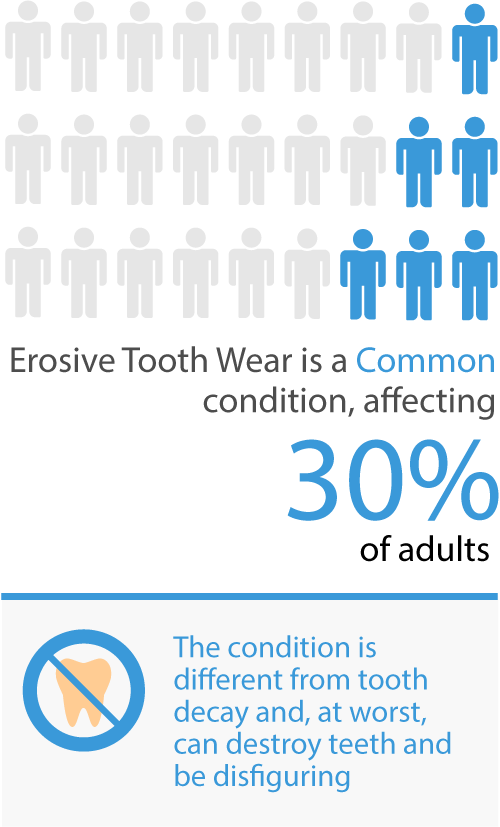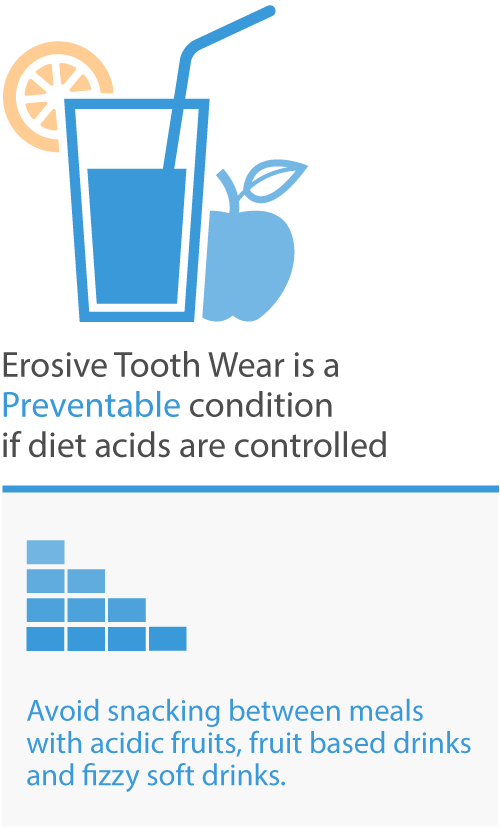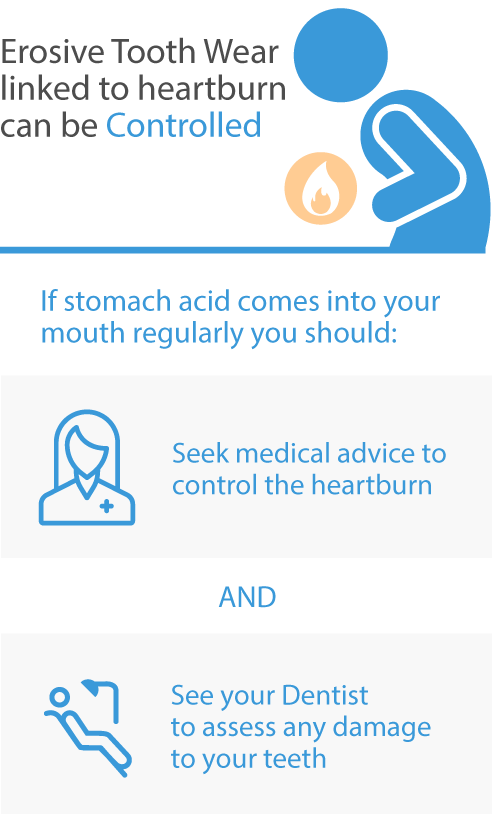What is Erosive Tooth Wear
When you look at your teeth, they seem solid, but actually the enamel, the outer layer of your tooth, can slowly dissolve if it’s surrounded by acid, such as that found in fruit juices or some fizzy drinks; this is known as ‘erosion’
- Erosion starts when minerals are removed from your teeth and softens the enamel
- The ingredients for re-hardening your teeth are found in saliva and fluoride in toothpastes so the softening can be repaired
Erosive Tooth Wear most often occurs on your front teeth and the biting surfaces of your back teeth
- Part or all of the outer layer of tooth, the enamel, may eventually be lost, exposing the inner layer, the dentin. This inner layer is more yellow and once exposed changes the colour of the teeth.
- You are not alone, erosive tooth wear is common, about a third of all adults have it, though few have it severely
- Read more about the structure of your teeth and how acid affects your teeth.
Causes of erosive tooth wear
One of the most common ways to wear away the tooth is by drinking and eating acidic drinks and foods outside meal times.
A number of drinks and some foods can contribute to erosive tooth wear but the amount of times you consume these, especially by frequent snacking, can also influence the amount of erosion
Fruit
Fruit-based drinks containing citric acid
Carbonated drinks
Alcoholic drinks
Other Foods
Acidic Sweets
Other causes can include:
The Statistics



Signs & Symptoms
Changes in the shape and/or appearance/colour of your teeth - Teeth may become shorter and thinner. It may be your dentist who first notices this but don’t wait, make an appointment if you are concerned about this, even if your teeth aren’t hurting
Sensitive teeth - Pain, sometimes severe, when eating or drinking, especially something cold, when exposed to wind or even when talking. Lasts a few seconds, once the stimulating factor is gone the sensitivity may stop
Prevention & Treatment
1. Avoid snacking on acidic fruit and drinks
- Cut down on snacking between meals on acidic food and drinks
- Fruit is an important part of a healthy diet. Snacking on acidic fruits, such as citrus, apples, pineapples, grapefruit can cause erosive tooth wear. But if you take thee fruits at meal times the risk is very low.
- Less acidic fruits – bananas, coconut
- Most erosive fruits – oranges, pineapple, grapefruit, apples
- Cut down on carbonated drinks and fruit juice
- Limit them to mealtimes so they are washed out of the mouth/diluted by food when swallowing
- Don’t sip over a long time
2. Fluoride toothpaste and mouthwash
- Fluoride combines with the ingredients in saliva to form a tougher version of enamel that is more resistant to acid
- Toothpaste should include at least 1450 ppm fluoride, if you have a problem with erosive tooth wear ask your dentist which is best for you
- Some toothpastes have ingredients optimised for the prevention of erosive tooth wear. Find out more about the causes of mechanical tooth wear here.
- However, don’t brush your teeth right after eating or drinking acidic foods or drinks.
- Surface softening by the acids and brushing teeth combine to remove enamel and cause Erosive Tooth Wear.
- Give time between eating and brushing your teeth.
- If you also suffer from sensitivity you may need a toothpaste with other ingredients.
- Only brush two times a day
- Use a soft-medium toothbrush
- Brush in a gentle, circular motion
- Do not brush immediately after anything acidic
- Seek medical advice if you have erosive tooth wear due to acid reflux or frequent vomiting
- If you are on a medication that causes dry mouth, ask if you can be switched to one that doesn’t. Do not stop taking any medication without first consulting your doctor
You can read more in our Patient FAQ's
Further Reading
How does acid affect my teeth?
How does erosive tooth wear differ from dental cavities/tooth decay?
Saliva and my teeth?
The pros and cons of restoring your teeth?
The structure of my teeth?
What causes mechanical tooth wear?
What causes sensitive teeth?
What do the other ingredients in toothpaste do?
What does fluoride actually do in erosive tooth wear?
